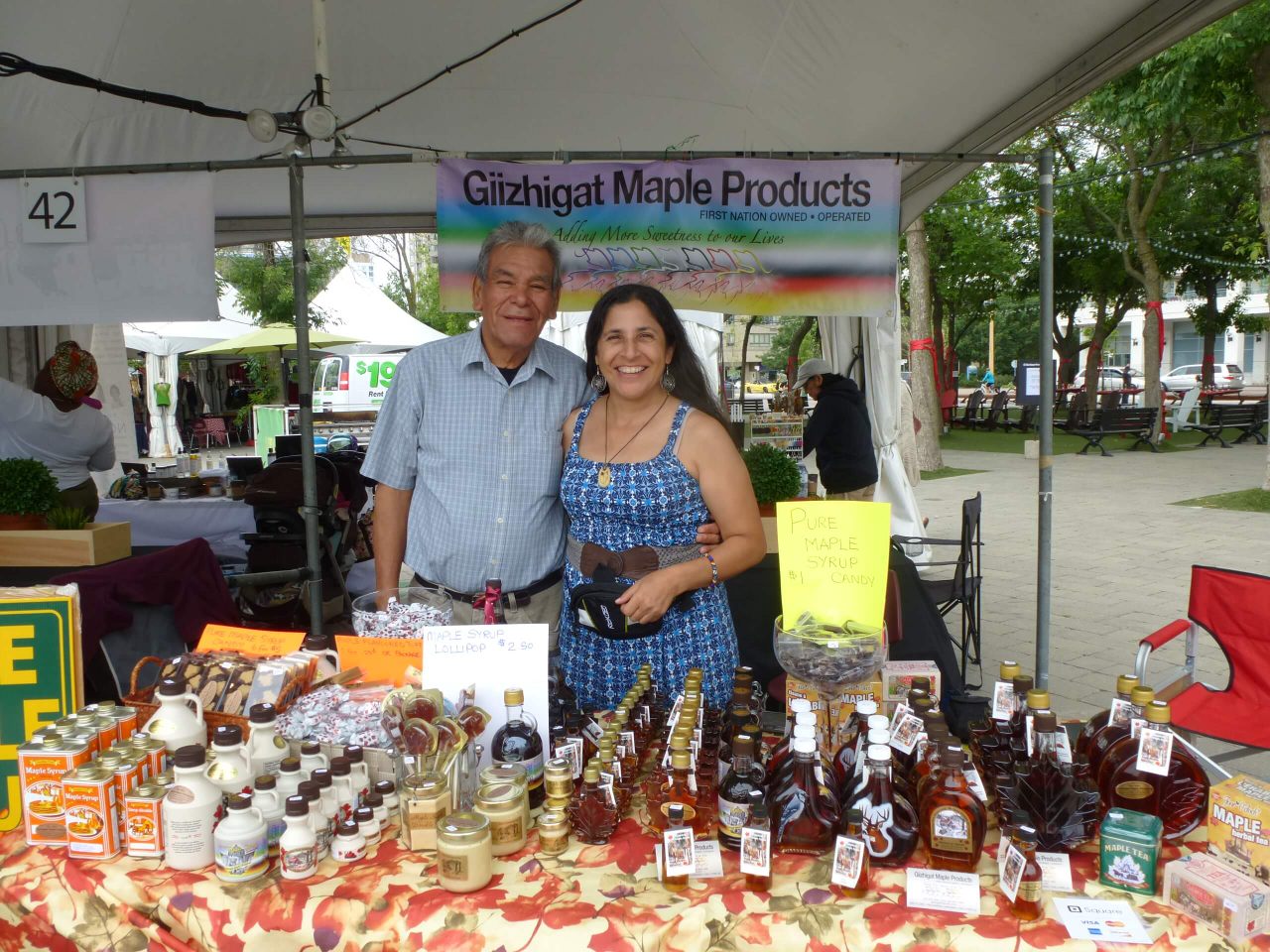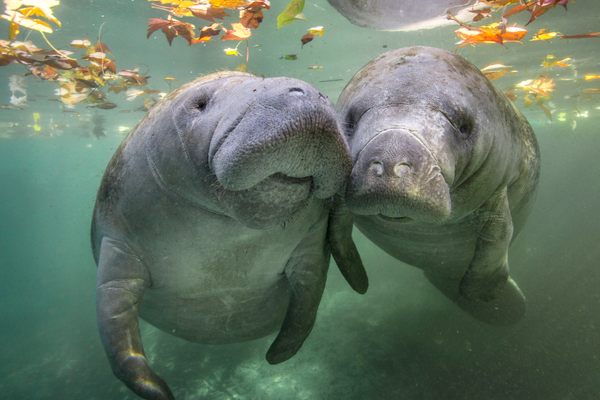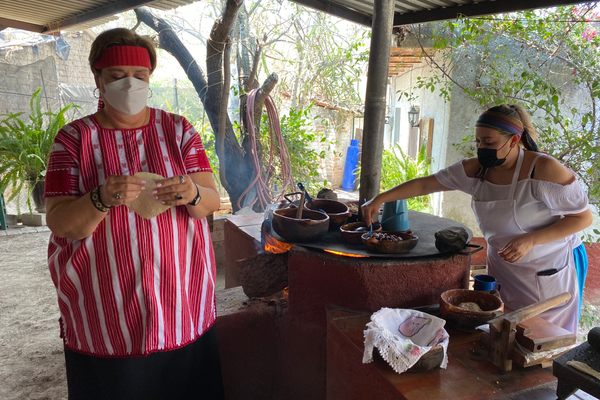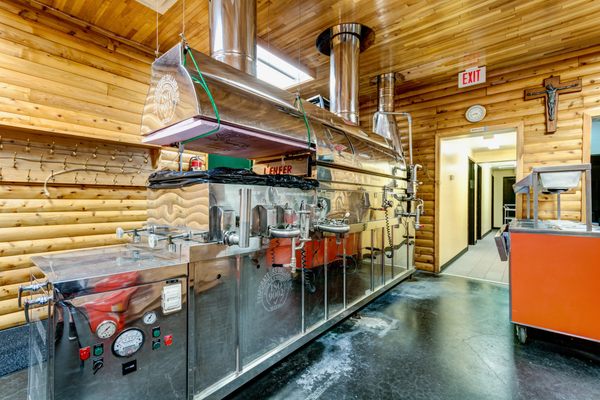Indigenous Maple Syrup Makers Tap Into Tradition
This sweet revolution reclaims an ancient craft.
Upon cutting down a tree in Canada one spring, the first European known to have tasted maple sap, Jacques Cartier, found a delicious elixir. There “gushed out from it a juice, which was found to taste as good and as delicious, as the fine wine of Orleans or Beaune,” reads a 1557 account of the event.
But centuries before the first European settler arrived in North America, Indigenous communities in Eastern Canada were harvesting sap from maple trees of the region, boiling the raw bounty, and turning it into sugar water, syrup, and maple sugar. Haudenosaunee traditional knowledge includes descriptions of cutting maple trees to access “sweet water,” and many Anishinaabe communities have sugaring-off traditions when they collect sap. Many used maple products not only for their delicious flavor, but also as medicine and even as a way to help preserve foods.
As of 2020, there were over 5,300 producers of maple syrup across the country, accounting for nearly 47 million tree taps nationwide. After all, Canada produces over 75% of the world’s maple syrup, most of which is harvested in Quebec. But there are only a handful of Indigenous-owned maple syrup companies across Canada, and even fewer Indigenous-owned sugar shacks.
There’s a quest for historical quaintness behind every aspect of maple syrup production, from the anachronistic glass bottles to the rustic charm of the sugar shacks. But what this popular imagery doesn’t capture is the Indigenous origin of maple syrup itself.

While only a small proportion of maple syrup producers in Canada are Indigenous, those who currently own their own maple farms and processing plants are proudly reclaiming their heritage. Many apply traditional methods and the teachings of elders to their work in an effort to keep that history alive.
When Europeans settled in Ontario in the 17th and 18th centuries, they cleared vast swaths of forest from the land, including the sacred maples and sugar maples, known for the sweetest saps. Research shows that during this era, Indigenous peoples lost much of their ability to harvest maple syrup. Then, the forced resettlements of the Indian Act of 1876 caused the disappearance of traditional maple ceremonies and festivals.
By then, settlers had learned the traditional processes and eventually industrialized maple syrup production. More recently, though, there has been an attempt at reconciliation through collaboration, and an effort to recognize maple syrup as an Indigenous creation. In the past, Sand Road Maple Farm in Moose Creek, Ontario has invited Ojibwe, Métis Cree, and Algonquin knowledge-keepers to lead smudging ceremonies and prayer at the start of their season.

But Indigenous-owned companies themselves are now making headway in the industry. Giizhigat (Gee-jah-gut) is located in Richard’s Landing, Ontario. Its Indigenous owners, Deborah Aaron, a member of Six Nations of the Grand River reserve, and Isaac Day, an elder and healer from Serpent River First Nation, use traditional teachings in their syrup-making approach. They bought their equipment in 2012 and completed their first maple syrup run in 2015.
Another Indigenous maple syrup producer, Kleekhoot Gold Bigleaf Syrup, is located on the West Coast’s Vancouver Island, in a region known as the Alberni Valley. Kleekhoot is run by members of the Hupacasath First Nation. The owners use Bigleaf maple trees, a tree unique to the West Coast of British Columbia, to produce their golden syrups. This tree creates syrups with caramel and vanilla notes.
Often, these companies combine tradition with contemporary technique. Wabanaki Maple, located in Tobique (or Neqotkuk First Nation) is not technically a maple-syrup producer. Instead, Wabanaki flavors and barrel-ages syrups, for unique aroma profiles such as rum, oak, whisky, and bourbon. Jolene Johnson, owner of Wabanaki, is Wolastoqiyik (Maliseet) and from Tobique. When she started her business in 2018, she was the first Indigenous woman working in the industry in the Atlantic provinces.

“I’m not aware of any other Indigenous female-led maple syrup companies in Canada at this time,” Johnson says. “But when I first embarked on my journey in 2018, I realized that there were very few Indigenous businesses in the maple syrup industry.”
In Maliseet culture, maple syrup would be heated during the preparation process to ensure stability and a long shelf life, Johnson says. “This was a practice done for many years in our culture, so supply could be kept throughout the long harsh winters in our territories,” Johnson explains. “The maple syrup would have been boiled down so that it was hard like maple candy, and then it could be stored more easily and broken down to use as maple sugar.” Wabanaki still uses this technique.
According to Johnson, maple syrup production within her own Maliseet culture was historically centered around the women—that each matriarch or head of the family would manage her own sugar grove, but it was still very much a community effort.“The responsibilities of the women would include things such as making hundreds of birch bark baskets to hang on the maple tree, so it could be gathered once the sap is flowing,” Johnson says. “They would also maintain the fires so the sap could be boiled down to syrup, candy or bricks.”
She can’t say what roles the men would have played in the process, but assumes that they would have helped too. “Perhaps gathering and providing the firewood or carving holes into the maple trees to allow for the sap to flow,” ” Johnson says. “These are only my thoughts, since much of the history of Indigenous people and maple syrup was not necessarily documented, but rather passed on through stories from generation to generation.”

For Johnson, working with maple is a community endeavor, as well as a family endeavor. “In fact, I was first introduced to maple syrup through my sister and her husband who have been collecting maple syrup as a hobby, and passed on a lot of teachings and knowledge to me,” Johnson says.
Besides creating unique maple syrups, Wabanaki also celebrates Indigenous culture through its Bareroots Initiative. This gift box project seeks to help support the environment and reforestation. “It is curated with products from other amazing Indigenous businesses across Turtle Island,” Johnson says, referring to the name for North America used by many First Nations peoples.
While there may not be many Indigenous-led maple syrup companies in Canada today, the ones who do this work should be celebrated, as they uphold their traditional values, advocate for the environment, and empower Indigenous youth to follow in their footsteps to reclaim their history. “As a 100-percent female, Indigenous-owned company, we care and are passionate about sharing our culture,” Johnson says. Making maple syrup, she says, is how she’s chosen “to help support and give back to our communities, and the next seven generations.”
Gastro Obscura covers the world’s most wondrous food and drink.
Sign up for our email, delivered twice a week.




























Follow us on Twitter to get the latest on the world's hidden wonders.
Like us on Facebook to get the latest on the world's hidden wonders.
Follow us on Twitter Like us on Facebook